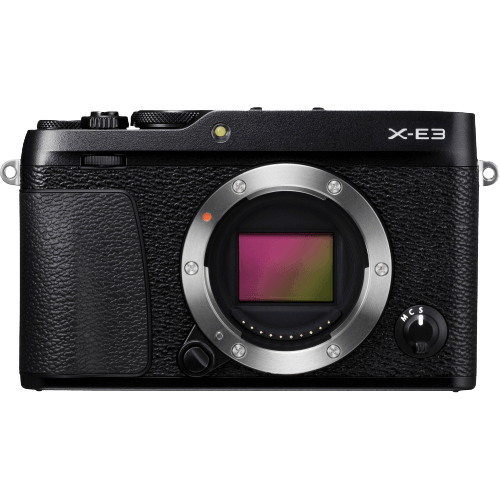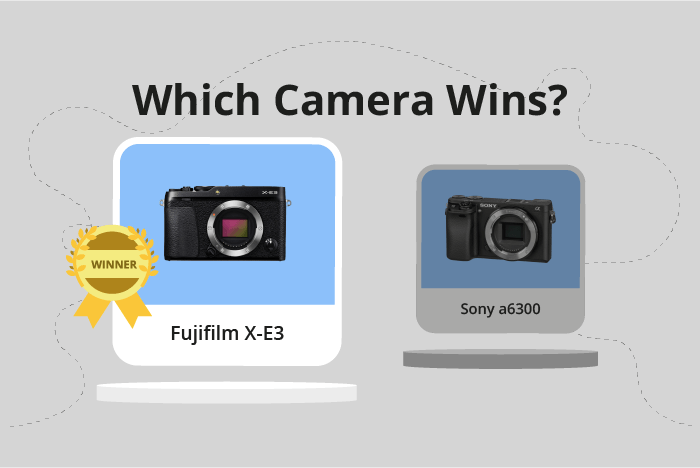Fujifilm X-E3 vs Sony a6300 Comparison
Fujifilm X-E3

Sony a6300

The Fujifilm X-E3 takes the lead with a score of 63/100, just two points higher than the Sony a6300‘s 61/100. Both cameras share similarities as mirrorless models, released in 2017 and 2016 respectively. The X-E3 boasts a lighter and more compact design, weighing 337g and measuring 121 x 74 x 43mm. This makes it more portable and convenient for travel and daily use.
However, the Sony a6300 has its advantages as well. While slightly heavier at 404g and a tad larger at 120 x 67 x 49mm, it was initially more expensive with a launch price of $1000, compared to the X-E3’s $899. This price difference may reflect the a6300’s additional features or build quality.
Both cameras have their strengths and weaknesses, but the Fujifilm X-E3 emerges as the winner due to its higher score, lighter weight, and lower launch price.
Fujifilm X-E3 vs Sony a6300 Overview and Optics
The Sony a6300 triumphs over the Fujifilm X-E3 in optics with a score of 68/100 compared to the X-E3’s 64/100. Both cameras share similarities, including 24-megapixel CMOS sensors, APS-C sensor sizes, and the absence of image stabilization. However, the differences in specifications reveal the reasons behind the higher score for the Sony a6300.
The Sony a6300 boasts a faster shooting speed of 11 frames per second, compared to the Fujifilm X-E3’s 8 frames per second. This advantage allows the a6300 to capture fast-moving subjects with greater ease and precision. Additionally, the Sony a6300 has a slightly higher megapixel count of 24.2, providing marginally better image resolution. Furthermore, the a6300’s sensor has a DXOMARK score of 85, attesting to its superior image quality. Conversely, DXOMARK does not score Fujifilm cameras, leaving the X-E3 without this performance benchmark.
Despite its lower score, the Fujifilm X-E3 also has its merits. It features the X-Processor Pro, a powerful processor that enhances the camera’s performance. While the Sony a6300 uses the Bionz X processor, the X-Processor Pro in the X-E3 may offer a more efficient workflow and better overall performance. Both cameras utilize their respective lens mounts, with the Fujifilm X-E3 using the Fujifilm X mount and the Sony a6300 using the Sony E mount.
Examining the optics of both cameras, the Sony a6300 emerges as the superior choice due to its faster shooting speed, slightly higher megapixel count, and DXOMARK-scored sensor. However, the Fujifilm X-E3 remains a strong contender with its powerful X-Processor Pro. Ultimately, the choice between these two cameras rests on individual preferences and specific photography needs.
Fujifilm X-E3 vs Sony a6300 Video Performance
The Sony a6300 outperforms the Fujifilm X-E3 in video capabilities, earning a score of 91/100 compared to the X-E3’s 69/100. Both cameras share some common specifications, such as a maximum video resolution of 4K and video dimensions of 3840 x 2160. However, there are notable differences that make the a6300 a superior choice for videographers.
The Sony a6300 offers a higher maximum video frame rate of 120fps, doubling the X-E3’s 60fps. This allows for smoother slow-motion footage and better overall video quality. Additionally, the a6300 has built-in time-lapse functionality, enabling users to create stunning time-lapse videos without the need for additional accessories or software.
While the Fujifilm X-E3 falls short in comparison to the a6300, it still delivers respectable video quality with its 4K resolution and 60fps frame rate. However, the lack of time-lapse functionality and lower frame rate make it a less versatile option for those focused on video production.
Considering the significant difference in video scores and the additional features offered by the Sony a6300, it is the better choice for videographers seeking high-quality footage and advanced options. The Fujifilm X-E3, while still capable of producing quality video, does not rival the a6300 in terms of video capabilities.
Fujifilm X-E3 vs Sony a6300 Features and Benefits
The Fujifilm X-E3 emerges as the winner in this comparison with a feature score of 70/100, while the Sony a6300 scores 54/100. Both cameras have a 3-inch screen, lack GPS, and include WiFi connectivity. However, the Fujifilm X-E3 surpasses the Sony a6300 in several aspects, making it the superior choice.
The Fujifilm X-E3’s screen resolution of 1,040,000 dots is higher than the Sony a6300’s 921,600 dots, providing clearer and sharper image previews. Additionally, the X-E3 has a touchscreen, which simplifies menu navigation and enhances user experience. The camera also features Bluetooth connectivity, allowing for seamless pairing with compatible devices and remote control options.
On the other hand, the Sony a6300 has a flip screen, which can be advantageous for shooting from different angles and taking selfies. This feature is absent in the Fujifilm X-E3. However, the flip screen alone does not compensate for the other benefits offered by the X-E3.
Considering the specifications, the Fujifilm X-E3 is the better camera due to its higher screen resolution, touchscreen, and Bluetooth connectivity. While the Sony a6300 offers a flip screen, it falls short in other areas, making the X-E3 the more attractive option for photographers seeking advanced features and functionality.
Fujifilm X-E3 vs Sony a6300 Storage and Battery
The Sony a6300 outperforms the Fujifilm X-E3 in storage and battery with a score of 24/100 compared to 21/100. Both cameras share similarities, featuring one memory card slot and compatibility with SD, SDHC, and SDXC cards. However, neither camera has USB charging capability.
The a6300 holds an advantage with its longer battery life, providing 400 shots per charge, while the X-E3 offers 350 shots. This difference in battery life makes the a6300 more suitable for extended photography sessions. The Fujifilm X-E3, though having a lower score, supports UHS-I compatible memory cards, which allow for faster read and write speeds. This feature is beneficial for photographers who require quick data transfer.
Considering these factors, the Sony a6300 is the better option for longer shooting sessions due to its superior battery life. However, the Fujifilm X-E3 offers quicker memory card performance, which may appeal to some users.
Alternatives to the Fujifilm X-E3 and Sony a6300
Are you still undecided about which camera is right for you? Have a look at these popular comparisons that feature the Fujifilm X-E3 or the Sony a6300:

